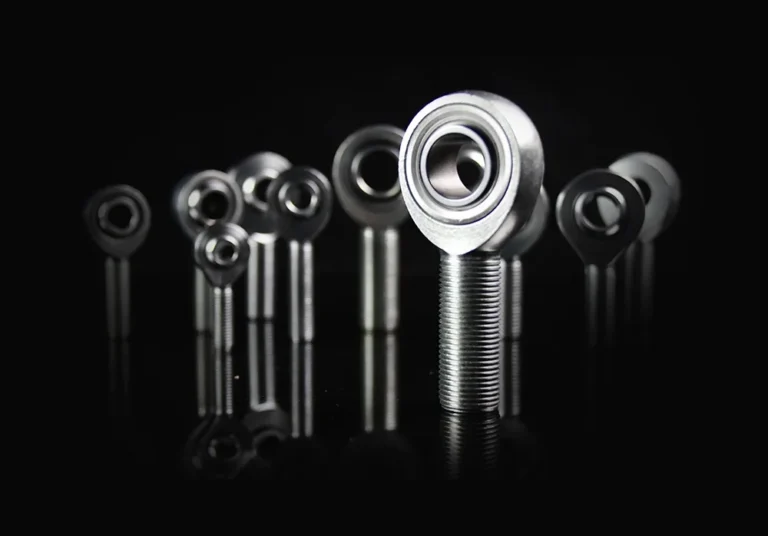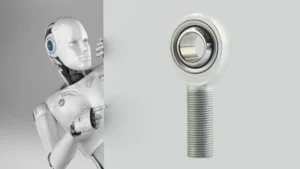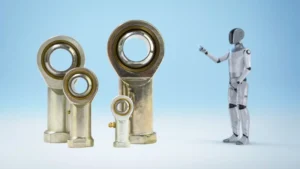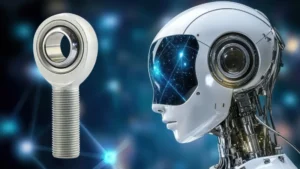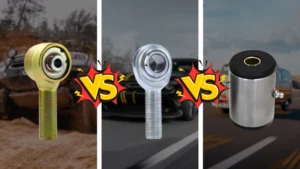A Heim joint, also known as a rod end, spherical rod end, or rose joint (in the UK), is a flexible mechanical connector designed to handle misalignment in motion systems. The name “Heim” comes from Lewis Heim, who patented the design during World War II for use in aircraft controls. Since then, rod ends have made their way into racing suspensions, agricultural linkages, and industrial equipment. To learn more, check out our article Rod Ends History
So… What Exactly Is a Heim Joint?
A Heim joint is a type of bearing—more specifically, a spherical plain bearing, which belongs to the family of sliding bearings rather than rolling bearings. That means it doesn’t rely on balls or rollers to reduce friction, but instead uses a smooth interface between parts to allow motion.
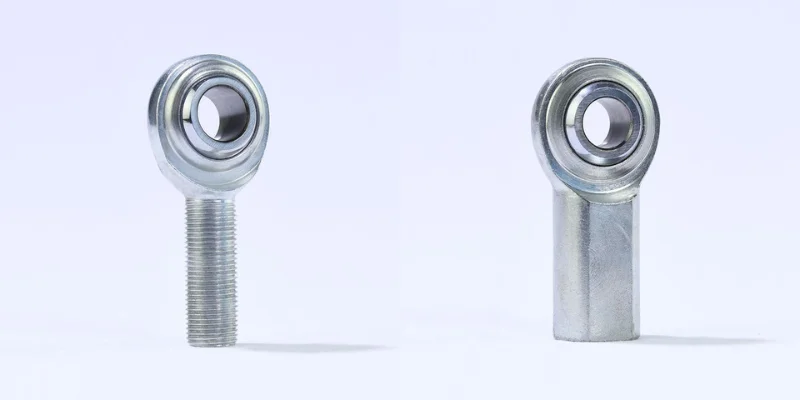
Spherical ball
Outer housing
Rod
Spherical ball
Outer housing
Rod
As shown in the image ‘A male heim joint and a female heim joint’ above, structurally, a Heim joint consists of three main components:
- A steel ball—with a pass-through hole for mounting
- An outer housing or race that holds the ball in place while allowing it to tilt and rotate.
- A rod that connects the Heim joint to the rest of the system.
These joints can come with a threaded shaft, a weldable base, or a female bore, depending on how they’re meant to be installed. While the ball is typically made of steel, the housing can vary in material—ranging from aluminum to stainless steel to reinforced plastic.
Importantly, Heim joints are part of the plain bearing category because the ball and housing interface directly, without rolling elements. This simple, compact design makes them ideal for accommodating misalignment while keeping connections structurally stable.
And while the term “Heim joint” is commonly used in North America, they’re also known globally as rod ends, rose joints, or spherical rod ends—all referring to the same clever mechanism.
What Does a Heim Joint Do?
Think of a Heim joint as a mechanical multitasker—it connects two parts while still allowing them to move. That’s what makes it so valuable in complex machines, vehicles, and performance setups.
1. Misalignment Compensation
One of the most important functions of a Heim joint is to handle angular misalignment. Thanks to its spherical design, the ball can tilt inside the housing—typically up to 30° in multiple directions—allowing the connected parts to pivot without stressing the joint.
2. Controlled Motion
Heim joints enable smooth rotational or oscillating movement between two connected components. Whether it’s a steering linkage or a suspension arm, the joint maintains connection while allowing parts to move independently.
3. Load Bearing
While they’re known for flexibility, Heim joints are also strong. They can handle radial loads (force perpendicular to the shaft) and moderate axial loads (force along the shaft), making them ideal for applications that involve force transmission under movement.
4. Precision and Adjustability
Many Heim joints are threaded or weldable, which means you can fine-tune the length of linkages for perfect geometry, whether you’re dialing in suspension or aligning machinery. That’s a big reason why they’re a favorite in racing and off-road systems.
5. Vibration & Wear Resistance
Some advanced Heim joints come with self-lubricating liners, which reduce metal-to-metal contact, minimize noise, and increase lifespan—perfect for repeated motion under rugged conditions.
In short, Heim joints offer strength, motion, and adjustability, all in a compact, versatile package. That’s why you’ll find them everywhere from high-speed race cars to industrial machines and rock-crawling Jeeps.
One big advantage of a Heim joint is its ability to maintain a secure connection even when parts aren’t perfectly aligned. Unlike fixed-angle connectors—like a clevis, which requires a strict 90-degree mounting—Heim joints can tolerate angular misalignment thanks to their spherical ball design.
For example, when a rod is terminated in two Heim joints, the shafts they connect don’t have to sit in a perfectly straight line. Under tension, the system allows for flexible movement. Under compression, the ball may tilt to the edge of its range, slightly cocking the link at an angle—yet the connection remains stable and reliable. That adaptability is exactly why Heim joints are trusted in real-world mechanical systems.
Heim Joint Components
Heim joints may all look alike at first glance, but inside, their construction varies depending on the type. In this section, we’ll break down the internal components of three common styles—Two-Piece, Three-Piece, and Injection-Molded—primarily focusing on the differences in the rod end (ball and housing), so you can better understand how each one works and why it matters.
1. Two-Piece Heim Joint
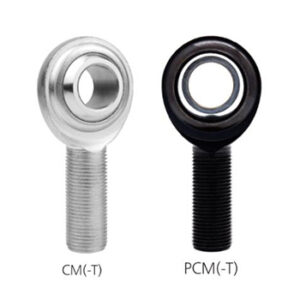
Two-piece rod ends are made up of just two parts:
- Spherical Ball – The pivoting element that allows rotation and angular movement.
- Outer Body – A solid metal housing with a cavity that holds the ball in place.
Depending on the design, the ball is secured by swaging, press-fit, or staking methods. This type doesn’t use a separate liner, which keeps the construction compact and cost-effective. The trade-off? It’s not serviceable—once it wears out, you replace it.
2. Three-Piece Heim Joint
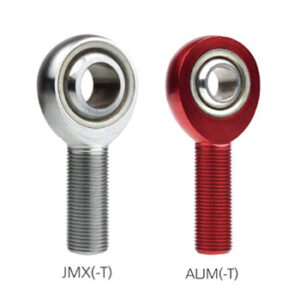
Three-piece rod ends are designed for high loads and high precision—ideal for performance-driven setups.
- Spherical Ball – Often chrome-plated or polished to reduce friction.
- Outer Housing – A sturdy metal shell that houses the ball and the liner.
- Liner (or Race) – The third component, usually made from PTFE, bronze, or a composite material. It sits between the ball and housing to minimize wear and vibration.
Some models use a loader slot to insert the ball sideways before locking it in place. These joints are favored for their durability and are often used in motorsports, off-road builds, and industrial robotics.
3. Injection-Molded Heim Joint
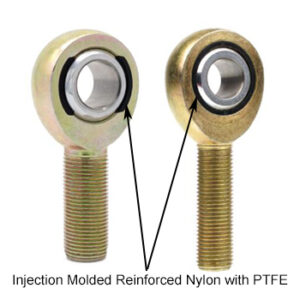
Structurally, this type is similar to the Three-Piece Heim Joint, but features a liner that is injection-molded directly into the housing.
- Metal Housing – Typically made from carbon steel, chromoly, or aluminum, providing high structural strength.
- Spherical Ball – Manufactured from 52100 bearing steel or stainless steel, precision-ground for smooth rotation.
- Liner – Instead of a separate drop-in race, a self-lubricating polymer (often reinforced with PTFE) is injected under high pressure between the ball and housing.
This process creates a perfect, zero-clearance fit. Injection-molded joints are excellent for vibration damping and resisting dirt entry, making them a solid choice for automotive suspension and rugged industrial applications.
Component Comparison
| Type | Components | Liner / Race | Assembly Method | Serviceability |
|---|---|---|---|---|
| Two-Piece | 1. Spherical Ball 2. Metal Housing (swaged / pressed) | None | Swaged (crimped), press-fit, or staked | Not serviceable (Replace as unit) |
| Three-Piece | 1. Spherical Ball 2. Liner / Race 3. Metal Housing | Yes (PTFE, Bronze, or Composite) | Ball inserted with race, then staked/swaged | Not serviceable (Replace as unit) |
| Injection-Molded | 1. Spherical Ball 2. Injected Liner 3. Metal Housing | Yes (Reinforced nylon with PTFE) | Polymer is injected between ball and housing | Not serviceable (Replace as unit) |
Screw Thread Types
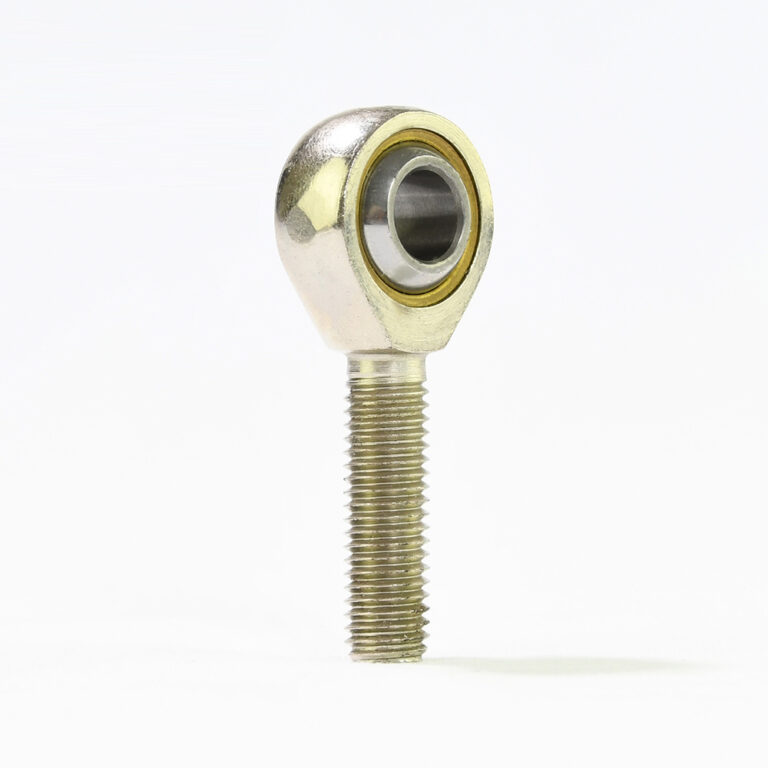

Heim joints come with two main thread types:
Male Thread: Found on the rod or shaft; screws into a female-threaded component.
Female Thread: Found on the housing; accepts a male-threaded rod or shaft.
Left-Hand vs. Right-Hand Threads
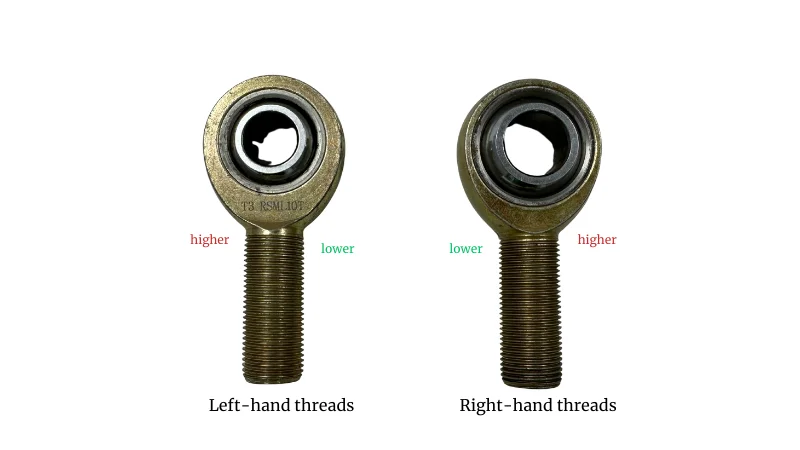
Right-Hand Threads: Standard threads that tighten clockwise (right-hand high) and loosen counterclockwise.
Left-Hand Threads: Tighten counterclockwise (left-hand high) and loosen clockwise, often used in pairs to prevent loosening in certain applications.
What Materials Are Used in Heim Joint Production?
While Heim joints may look simple on the outside, their performance depends heavily on the materials used in each part. Different types of Heim joints use different combinations of steel, aluminum, bronze, and engineered plastics, tailored for specific needs like strength, corrosion resistance, or weight savings.
1. Two-Piece Heim Joint
Ball: Commonly made from 52100 bearing steel or 440C stainless steel, both of which are precision-ground, heat-treated, and chrome plated for wear resistance and smooth movement.
Body: Typically uses carbon steel with zinc plating, or 304 stainless steel for corrosion resistance. Some models use 4130 chromoly steel for added strength.
2. Three-Piece Heim Joint
Ball: Same as above—52100 bearing steel or 440 stainless steel, both hardened and chrome-plated.
Race / Liner: This is where material variety kicks in. Liners can be made from PTFE, bronze or bronze power composite, depending on the load and lubrication needs.
Body: Ranges from chromoly steel and carbon steel to 7075-T6 aircraft-grade aluminum, often finished with anodizing or zinc plating for corrosion resistance and visual appeal.
3. Injection-Molded Heim Joint
Ball: Usually the same 52100 bearing steel, treated for strength and durability.
Race: Made from reinforced nylon with PTFE, offering low friction and self-lubrication.
Body: Can be made from chromoly steel or 7075-T6 aluminum, often anodized in red, black, or custom colors for lightweight, corrosion-resistant applications.
The materials listed above cover the majority of common applications, but some setups call for something more specific—like extra corrosion resistance, food-safe components, or unusual size and weight requirements. In those cases, we can help. We offer custom CNC machining service support, from unique material sourcing to precision machining, to ensure your Heim joints fit your exact requirements.
Final Thoughts
Heim joints may be small components, but their impact on performance, precision, and reliability is massive. Whether you’re building a race car, upgrading a steering linkage, or engineering an industrial system, understanding the types, structures, and materials behind rod ends can help you spec the right part for the job.
If you’d like to see how this basic knowledge connects to materials, types, performance, and applications, check out our Wholesale Heim Joints Buyers’ Guide.


